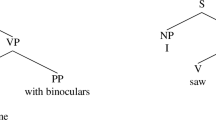Abstract
Central for the discussion about the pros and cons of pictorial representations is the indeterminacy problem. Whereas propositional representations can be underdetermined, it is a widespread opinion that pictorial representations are completely determined and committed to details. In contrast to this view, which is held — for example by Dennett, Pylyshyn and Iorger — in the present paper a variable system of commitments is proposed: Users of pictorial representations have alternatives with respect to interpretations and commitments since there are implicit annotations to these representations. The annotations refer to axiomatized geometric systems, which — from a cognitive point of view — can be seen as systems of commitments.
Zusammenfassung
In der Diskussion über die Vor- und Nachteile piktorieller Repräsentationen nimmt das Problem der Bestimmtheit eine zentrale Rolle ein: Während propositionale Repräsentationen unterbestimmt sein können, d. h. Details des Repräsentierten einfach unerwähnt lassen können, scheint es im Wesen piktorieller Repräsentationen zu liegen, daß sie vollständig bestimmt und somit zu Detaillierungen verpflichtet sind. Im Gegensatz zu dieser Ansicht, die u. a. Dennett Pylyshyn und Iorger vertreten, wird hier ein System variabler Verpflichtungen vorgestellt: Piktorielle Repräsentationen besitzen Interpretations- und Verpflichtungsalternativen, die durch Annotationen der Repräsentation ermöglicht werden. Die hier vorgeschlagenen Annotationen sind Verweise auf Axiomatisierungen geometrischer Systeme, die unter einer kognitionswissenschaftlichen Perspektive als Verpflichtungssysteme aufgefaßt werden können.
Similar content being viewed by others
Literatur
Barwise, J. & Etchemendy, J. (1995). Heterogeneous logic. In J. Glasgow, H. Narayanan & B. Chandrasekaran (eds.): Diagrammatic Reasoning: Cognitive and Computational Perspectives. (pp. 211–234). Cambridge, MA: MIT-Press.
Block, N. (1981). Introduction: What is the Issue? In N. Block (ed.), Imagery (pp. 1–18). Cambridge, MA: MIT-Press.
Dennett, D.C. (1969). The nature of images and the introspective trap. In D.C. Dennett, Content and Consciousness (pp. 132–141). London: Routledge & Kegan Paul.
Eschenbach, C.; Habel, Ch.; Kulik, L. & Leßmöllmann, A. (im Ersch.). Shape Nouns and Shape Concepts: A Geometry for ‚Corner’. In C. Freksa, Ch. Habel & K. Wender. (eds.)Spatial Cognition. Berlin: Springer-Verlag.
Eschenbach, C.; Habel, Ch. & Leßmöllmann, A. (1997). The intepretation of complex spatial relations by integrating frames of reference. In Proceedings of the AAAI Workshop ‚„Language and Space” (pp. 45–56). In Patrick Oliver, (ed.) 14th National Conference on Artificial Intelligenc (AAAI-97), Providence, RI. (July 27-28, 1997)
Eschenbach, C. & Kulik, L. (1997). An axiomatic approach to the spatial relations underlying ‚left‘—’right’ and ‚in front of‘—rsbehind’. In G. Brewka, C. Habel & B. Nebel (eds.), KI-97 — Advances in Artificial Intelligence 207–218. Berlin: Springer-Verlag
Freksa, C. (1992). Temporal reasoning based on semi-intervals. Artificial Intelligence, 54 199–227.
Glasgow, J. & Papadias, D. (1992). Computational imagery. Cognitive Science, 16, 355–394
Habel, Ch. (1987). Cognitive Linguistics: The Processing of Spatial Concepts. T.A. Informations -ATALA (Association pour le Traitement Automatique des Langues), 28, 21–56
Habel, Ch. & Eschenbach, C. (1995). Abstrakte Räumlichkeit in der Kognition. Kognitionswissenschaft, 4, 171–176.
Habel, Ch. & Eschenbach, C. (1997). Abstract structures in spatial cognition. In C. Freksa, M. Jantzen & R. Valk (eds.). Foundations of Computer Science — Potential — Theory — Cognition. (pp. 369–378). Berlin: Springer-Verlag.
Habel, Ch.; Pribbenow, S. & Simmons, G. (1995). Partonomies and Depictions: A Hybrid Approach. In J. Glasgow, H. Narayanan & B. Chandrasekaran (eds.): Diagrammatic Reasoning: Cognitive and Computational Perspectives (pp. 627–653). Cambridge, MA: MIT-Press.
Haugeland, J. (1987). An overview of the frame problem. In Pylyshyn, Zenon (ed.) The robot’s dilemma: The frame problem in artificial intelligence (pp. 77–93). Norwood, NJ: Ablex.
Hilbert, D. (1899; 8 Aufl. 1956). Grundlagen der Geometrie. Stuttgart: Teubner
Ioerger, T.R. (1994). The manipulation of images to handle indeterminacy in spatial reasoning. Cognitive Science 18, 551–593.
Jackendoff, R. (1996). The architecture of the linguistic-spatial interface. In P. Bloom; M.A. Peterson; L. Nadel & M.F. Garrett (eds.), Language and Space (pp. 1–30). Cambridge, MA: MIT Press.
Johnson-Laird, P.N. & Byrne, R.M.J. (1991). Deduction. Hillsdale NJ.: Lawrence Erlbaum.
Klein, F. (1893). Vergleichende Betrachtungen über neuere geometrische Forschungen. Mathematische Annalen 43. 63–100. (Neudruck (1995) Ostwalds Klassiker der exakten Wissenschaften. Thun und Frankfurt am Main: Verlag Harri Deutsch.
Kosslyn, S.M. (1980). Image and Mind. Cambridge, MA.: Harvard UP.
Kosslyn, S.M. (1994). Image and Brain. Cambridge, MA.: MITPress.
Landau, B. & Jackendoff, R. (1993). „What” and „where” in spatial language and spatial cognition. Behavioral and Brain Sciences, 16, 217–238, 255–266.
Levinson, S. C. (1996). Frames of reference and Malyneux’s question: Crosslinguistic evidence. In P. Bloom; M. A. Peterson; L. Nadel & M. F. Garrett (eds.), Language and space (pp. 109–169). Cambridge, MA: MIT-Press.
Myers, K. & Konolige, K. (1995). Reasoning with analogical representations. In J. Glasgow, H. Narayanan & B. Chandrasekaran (eds.): Diagrammatic Reasoning: Cognitive and Computational Perspectives (pp. 273–301). Cambridge, MA: MIT-Press.
Palmer, S.E. (1978). Fundamental aspects of cognitive representations. In E. Rosch & B. Lloyd (eds.), Cognition and categorization (pp. 259–303). Hillsdale, NJ.: Lawrence Erlbaum.
Pylyshyn, Z. (1973). What the mind’s eye tells the mind’s brain. Psychological Bulletin 80, 1–24.
Raiman, Olivier (1991). Order of magnitude reasoning. Artificial Intelligence 51, 11–38.
Tarski, A. (1959). What is elementary geometry? In L. Henkin, P. Suppes & A. Tarski (eds), The axiomatic method, with special reference to geometry and physics (pp. 16–29) Amsterdam: North-Holland.
Author information
Authors and Affiliations
Corresponding author
Additional information
Die im vorliegenden Aufsatz dargestellten Überlegungen zu räumlichen und piktoriellen Repräsentationen stehen in engem inhaltlichem Zusammenhang mit dem DFG-Projekt „Axiomatische Charakterisierung räumlicher Konzepte” (ARK/Ha 1237/7); den ARK-KollegInnen danke ich für wichtige Diskussionen und zahlreiche Anregungen zu axiomatischen Charakterisierungen. Außerdem möchte ich Thomas Barkowsky, Carola Eschenbach, Barbara Kaup und zwei anonymen Gutachtern danken, die Vorfassungen dieses Aufsatzes kritisch gelesen und kommentiert haben. Ich möchte mich bei ihnen und den LeserInnen dafür entschuldigen, dass ich einige der Vorschläge nicht berücksichtigt habe. Mein Dank gilt schließlich den Veranstaltern und TeilnehmerInnen des Kolloquiums ‚Spatial Mental Models’ (Freiburg) für Einwände und Anregungen.
Rights and permissions
About this article
Cite this article
Habel, C. Piktorielle Repräsentationen als unterbestimmte räumliche Modelle. Kognit. Wiss. 7, 58–67 (1998). https://doi.org/10.1007/BF03354925
Published:
Issue Date:
DOI: https://doi.org/10.1007/BF03354925



